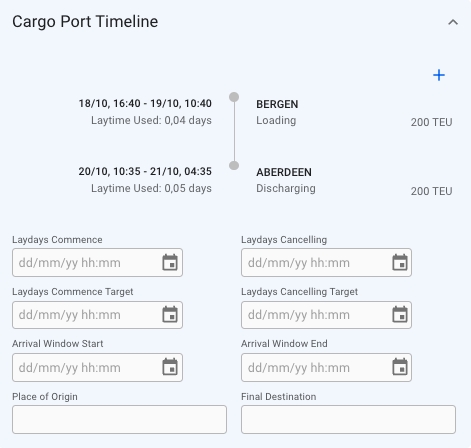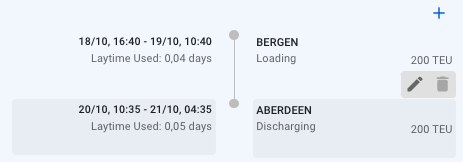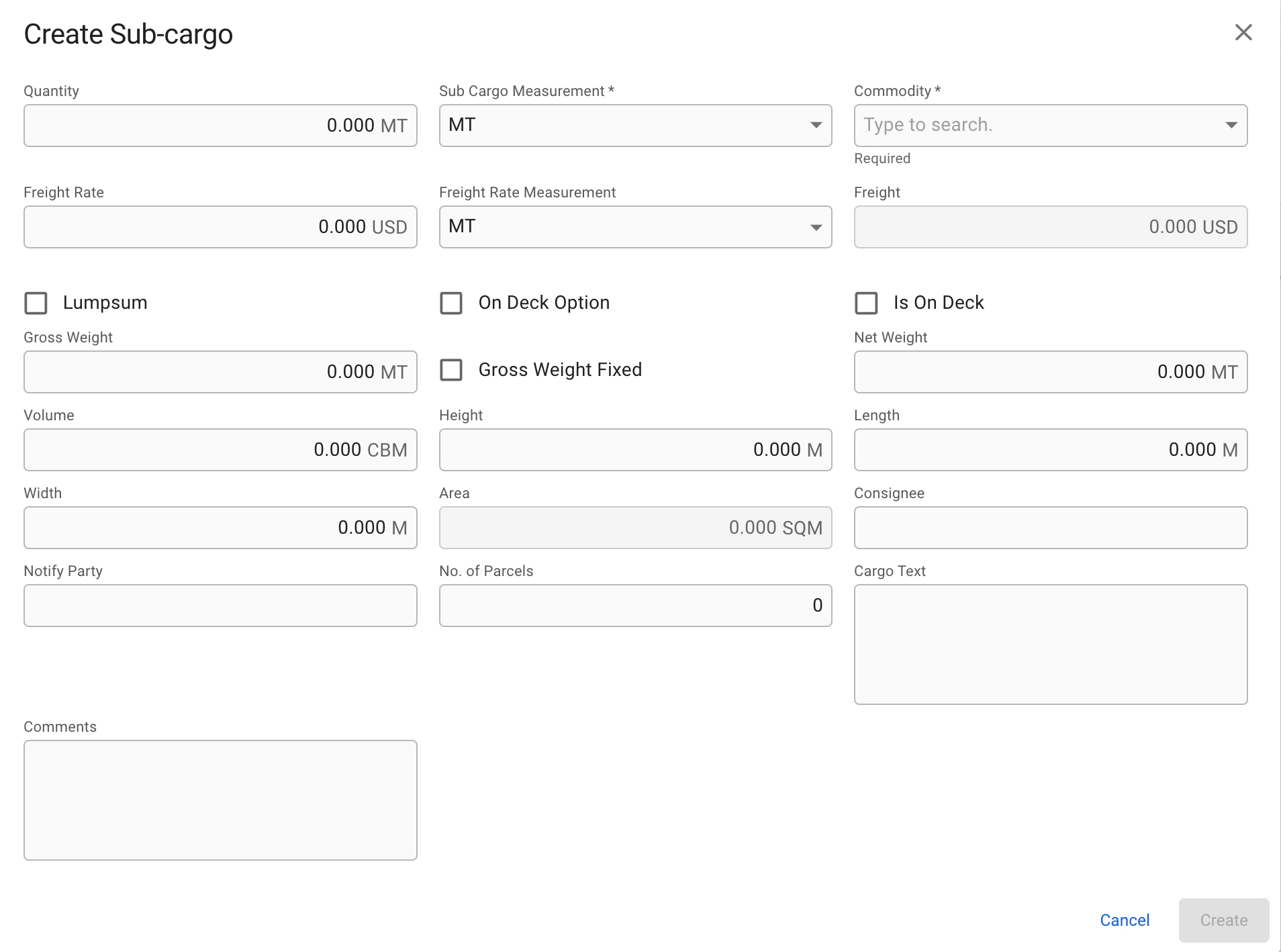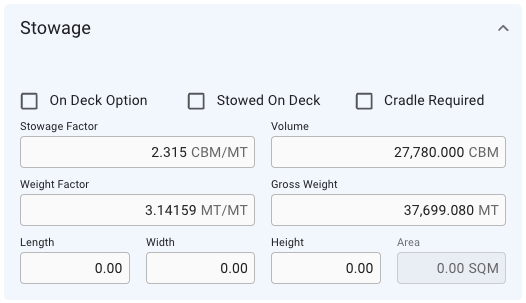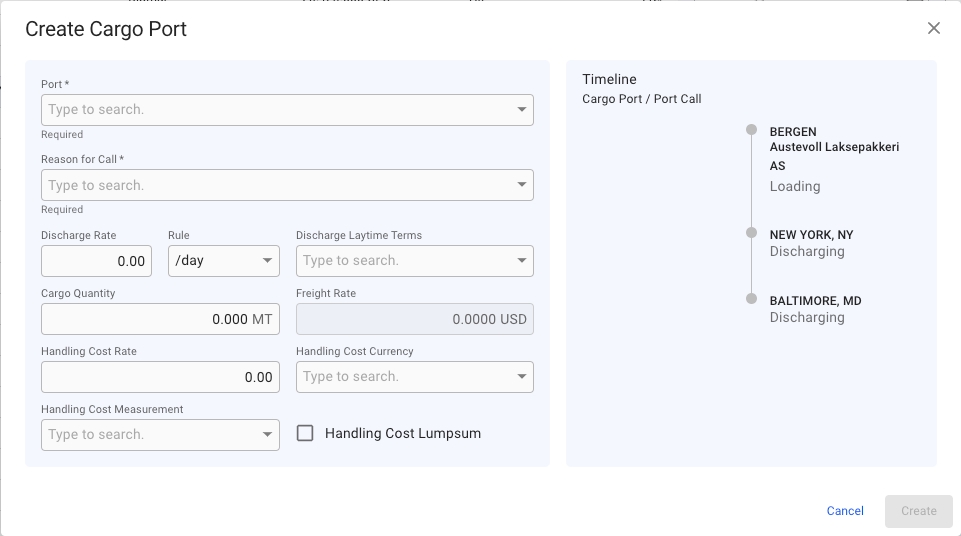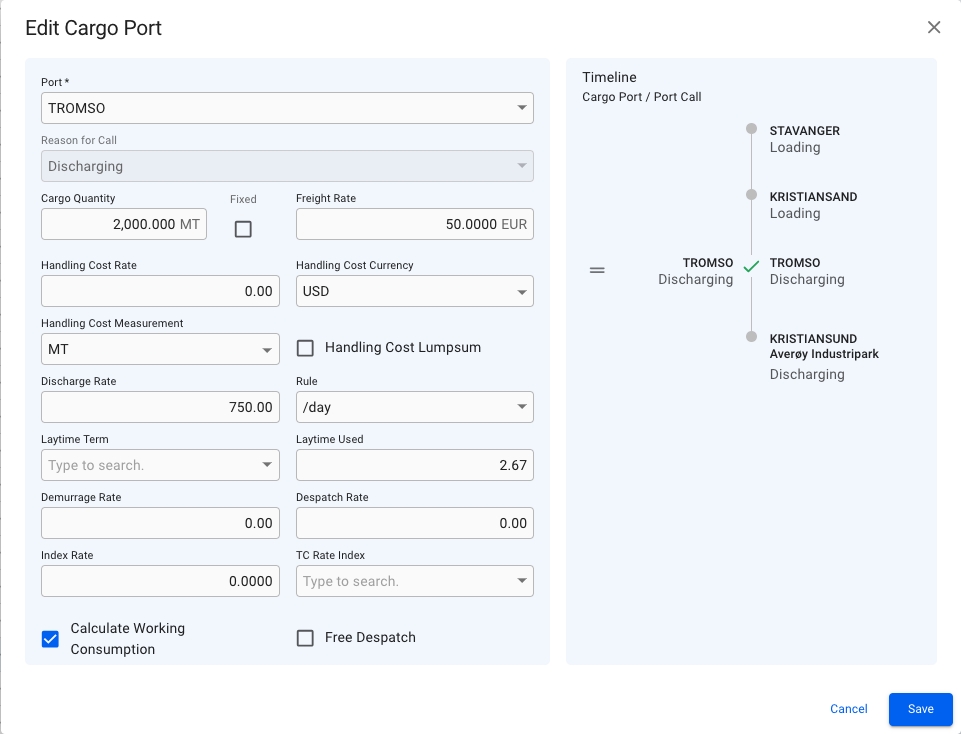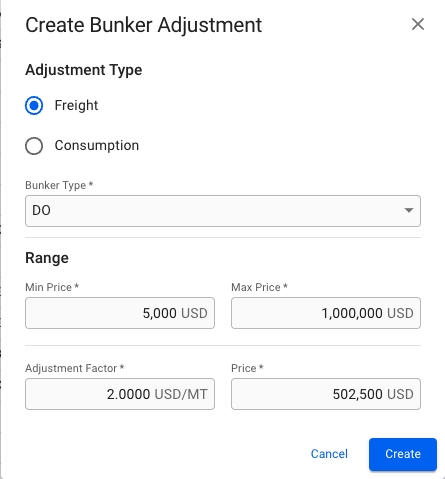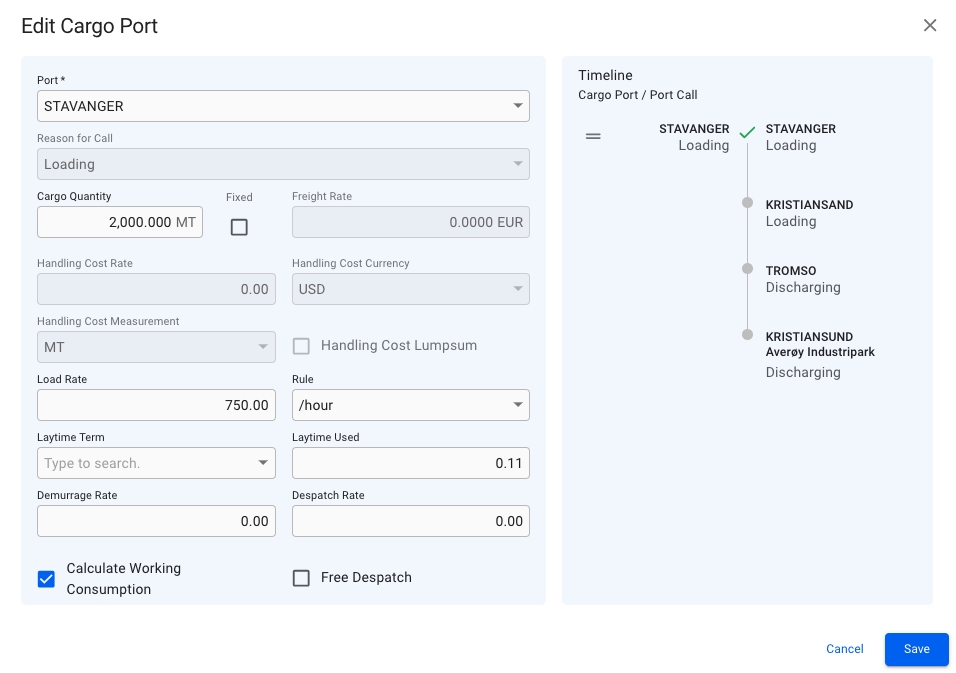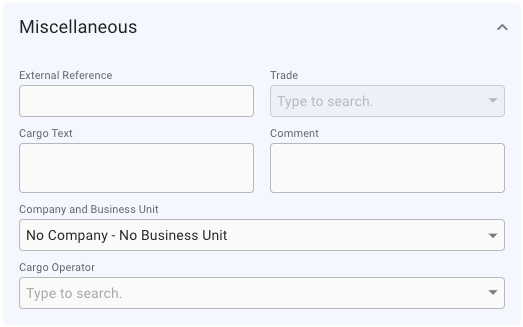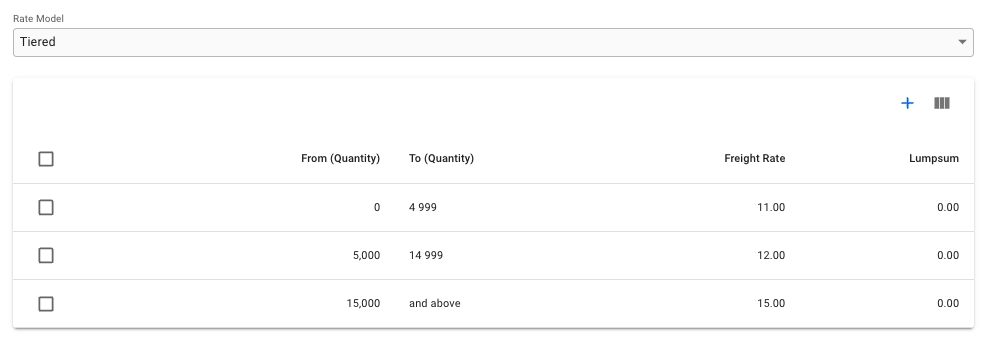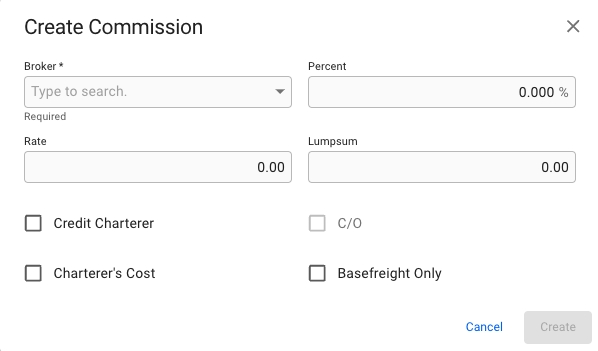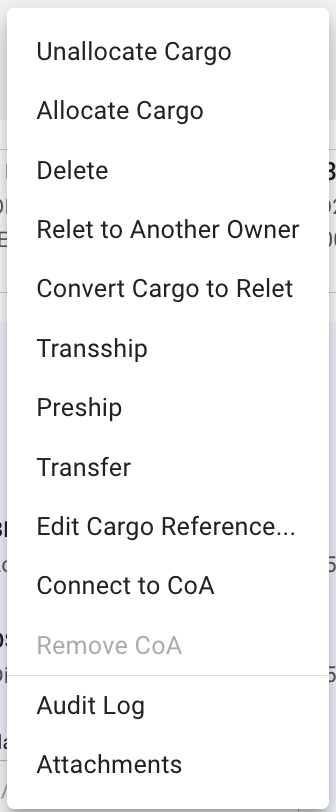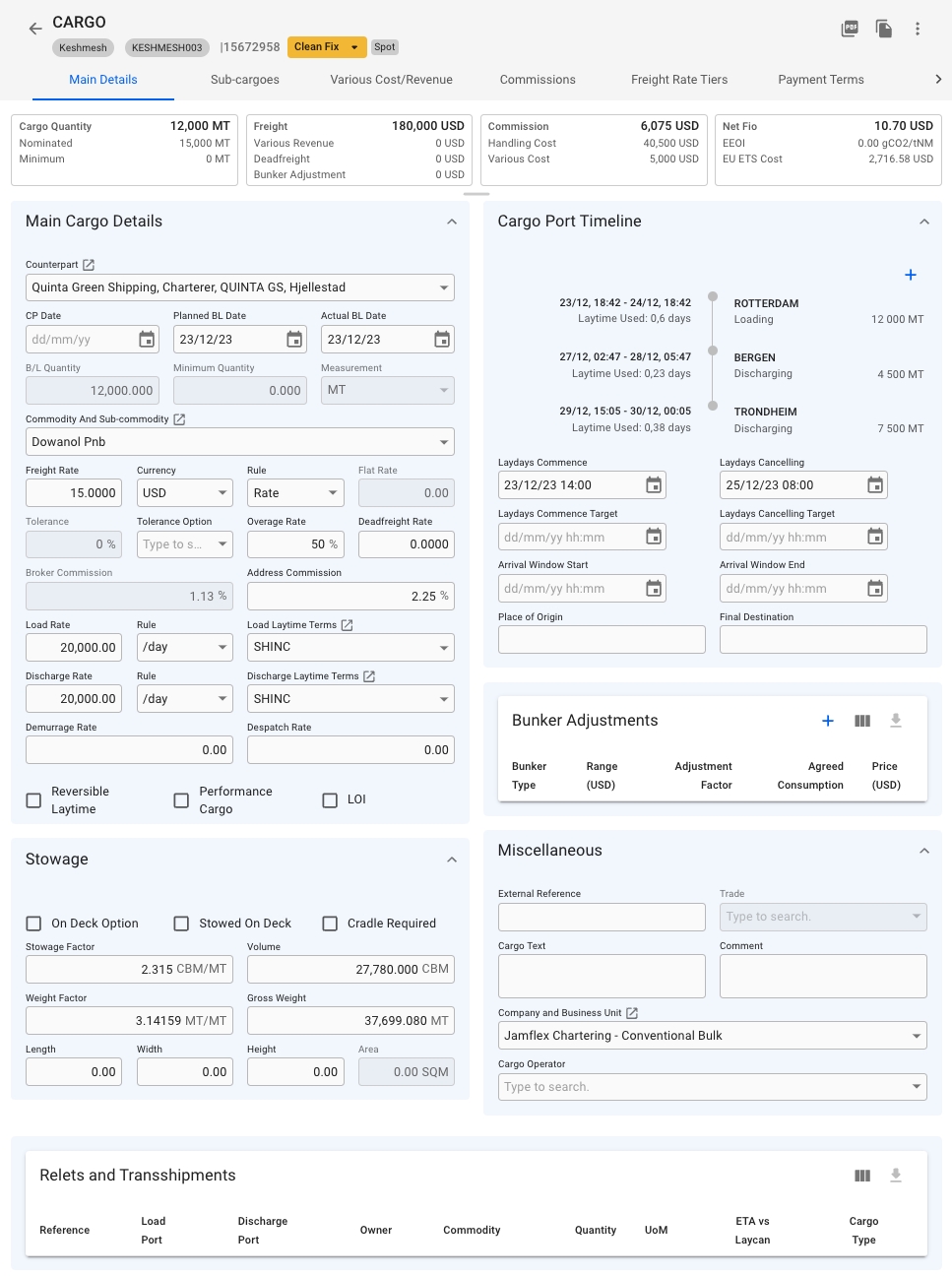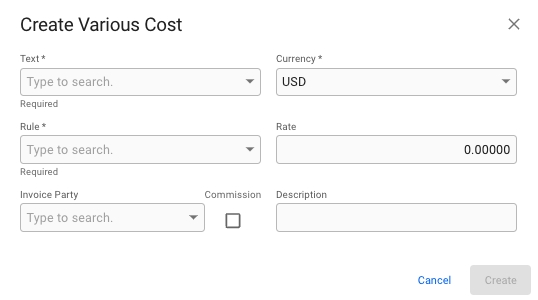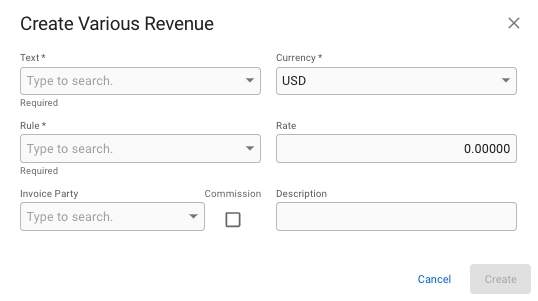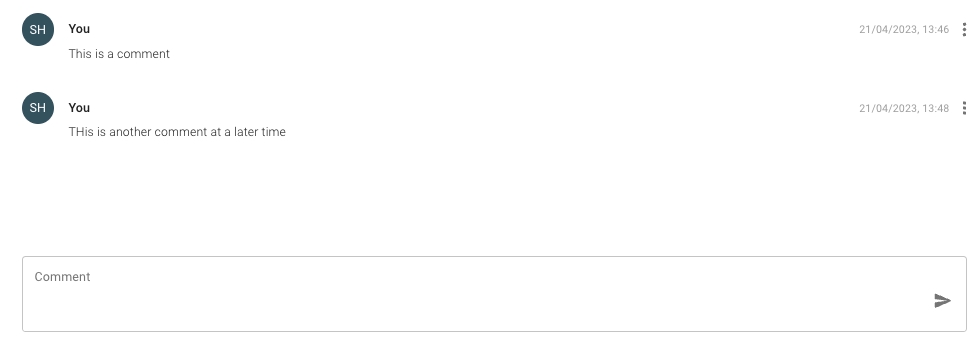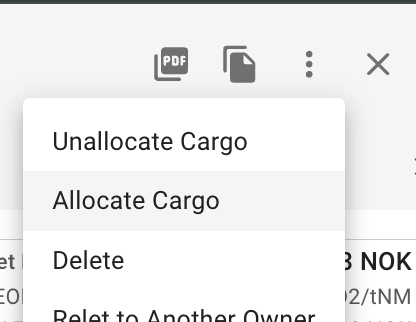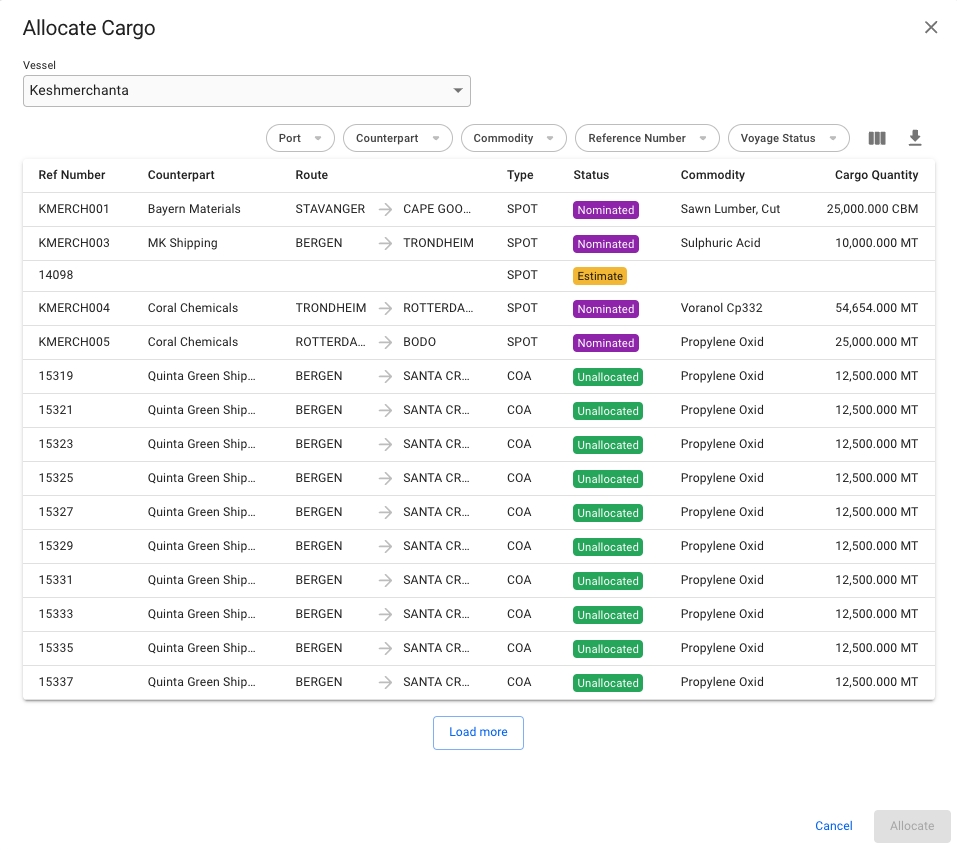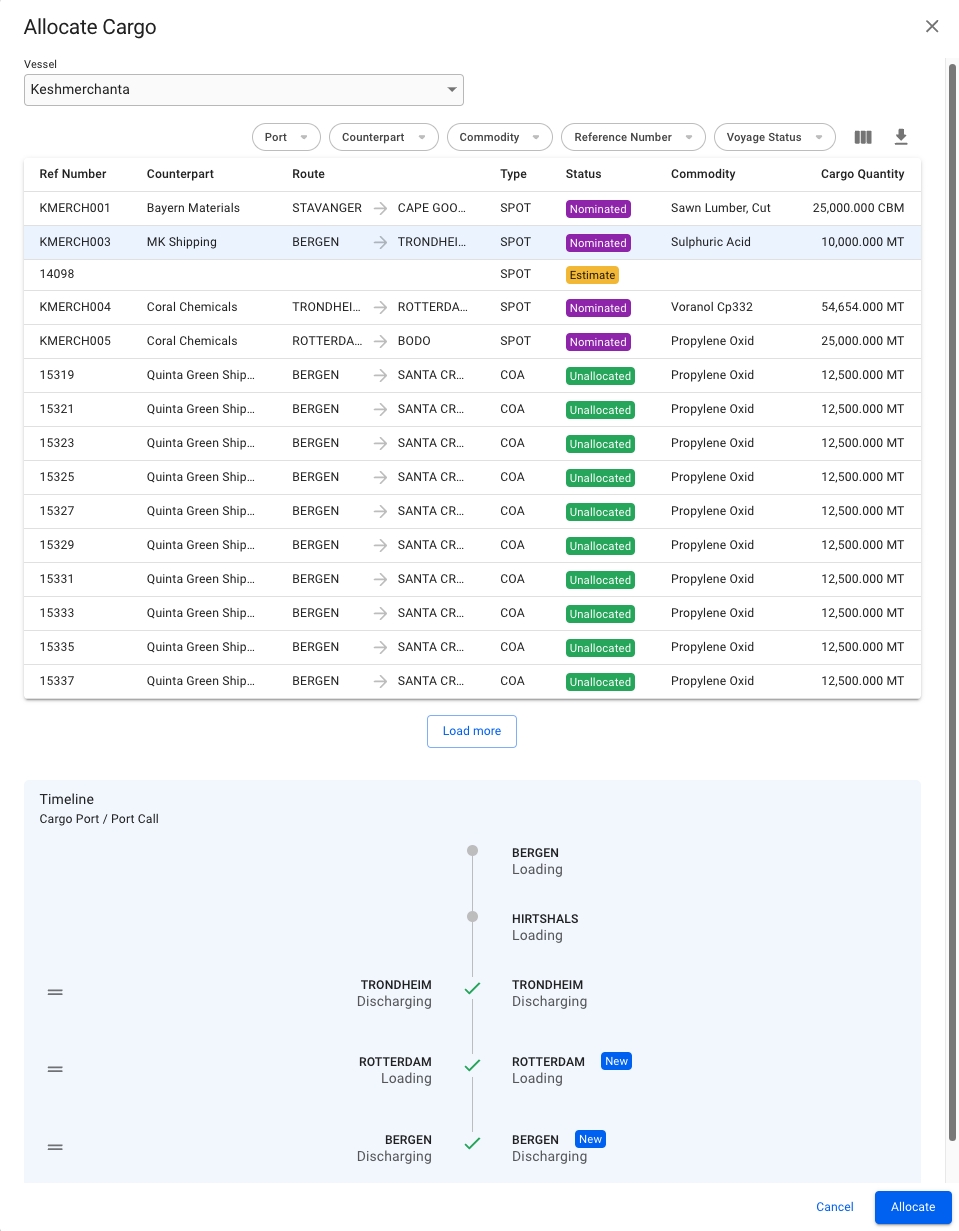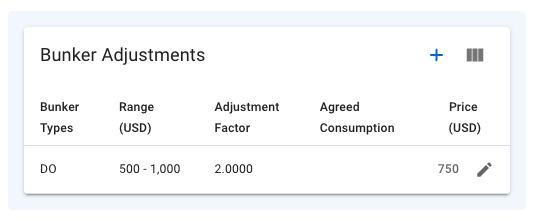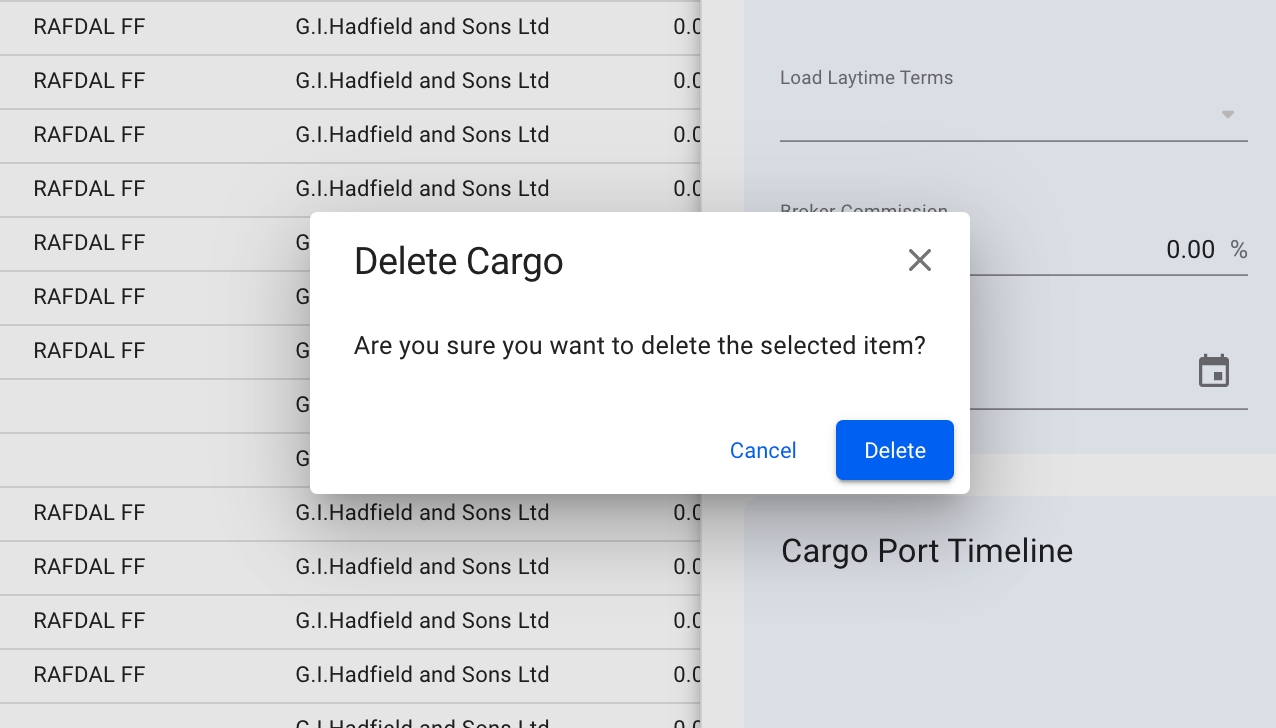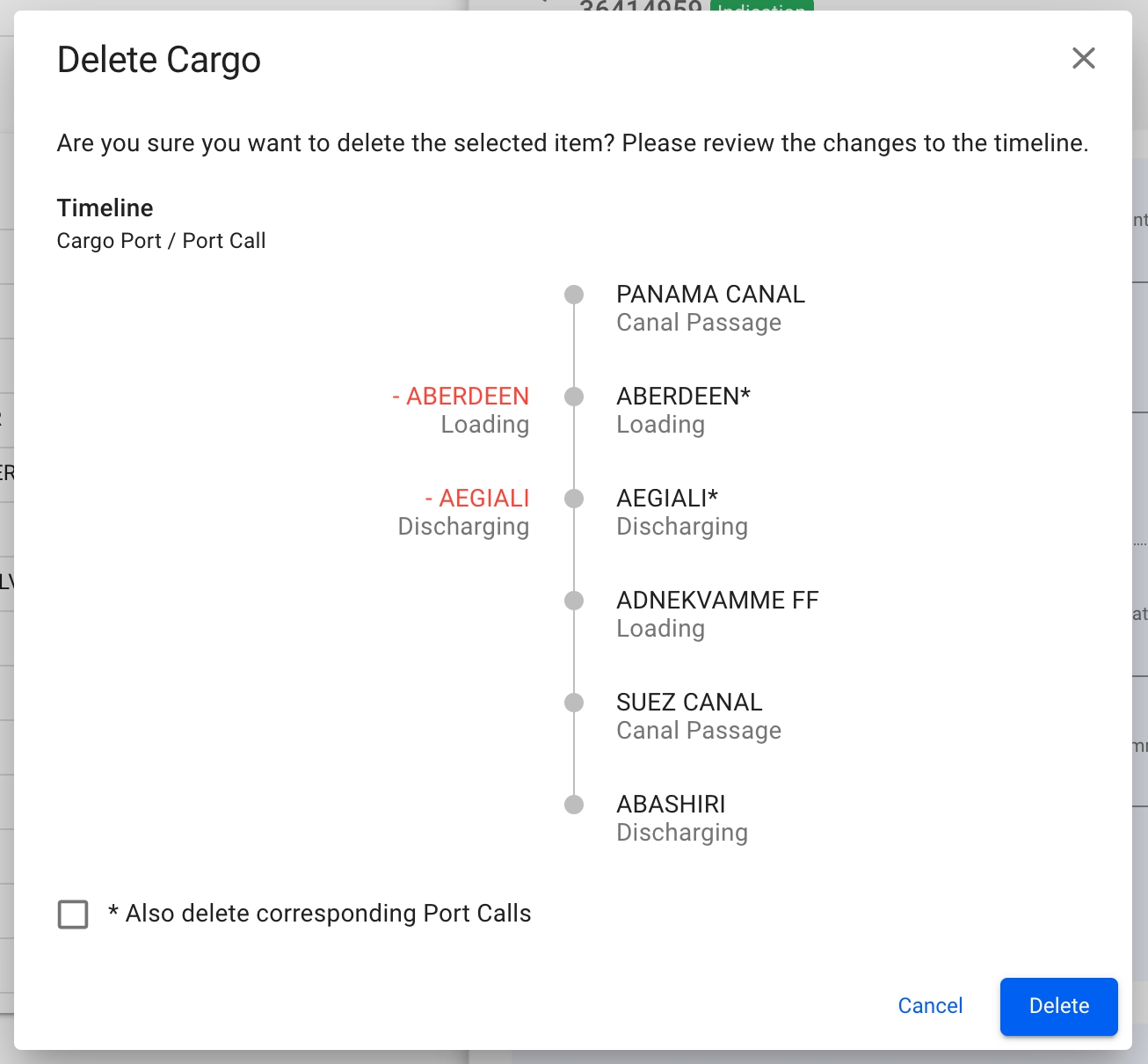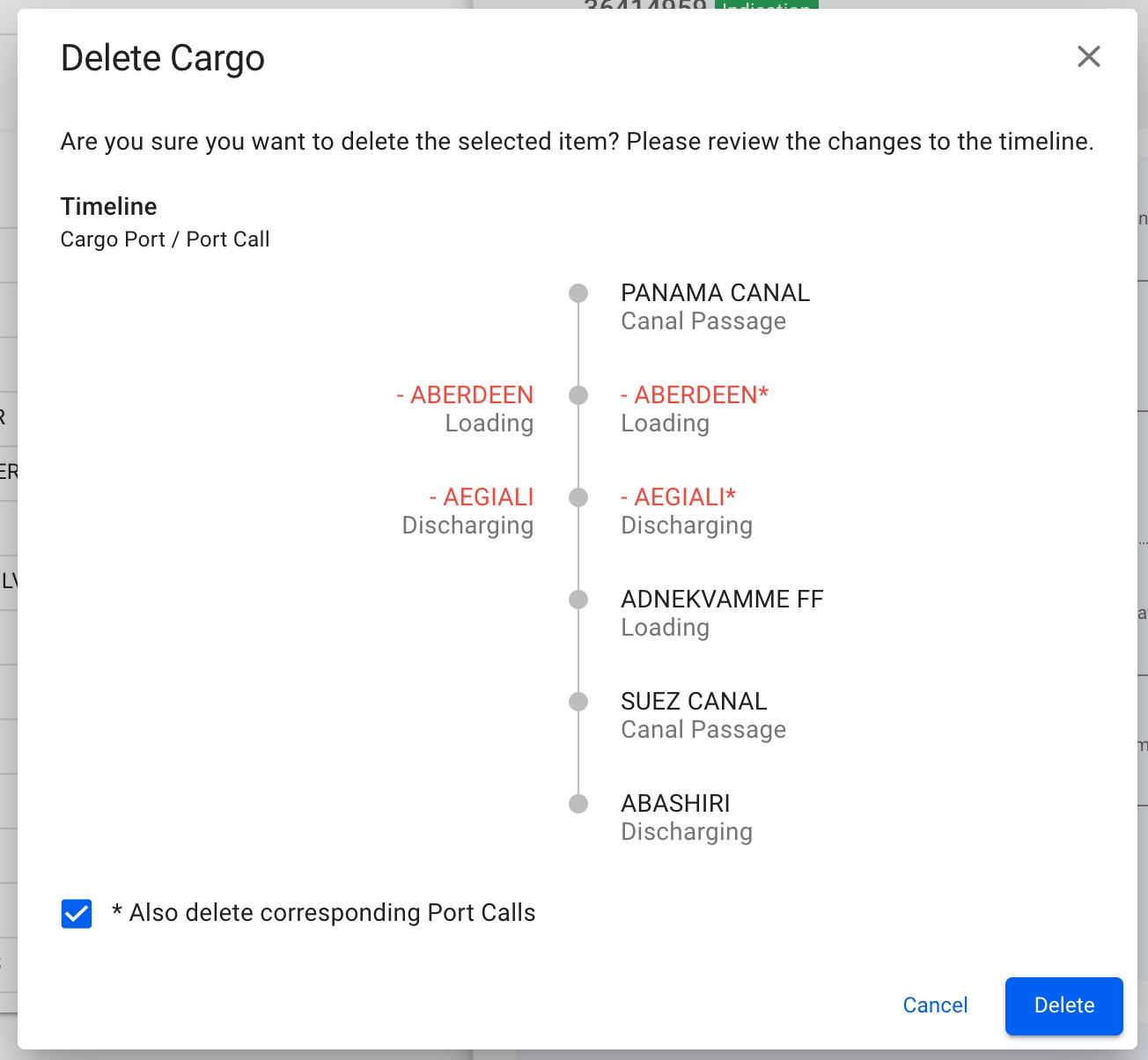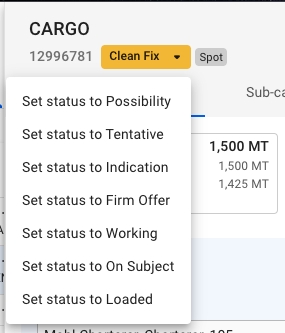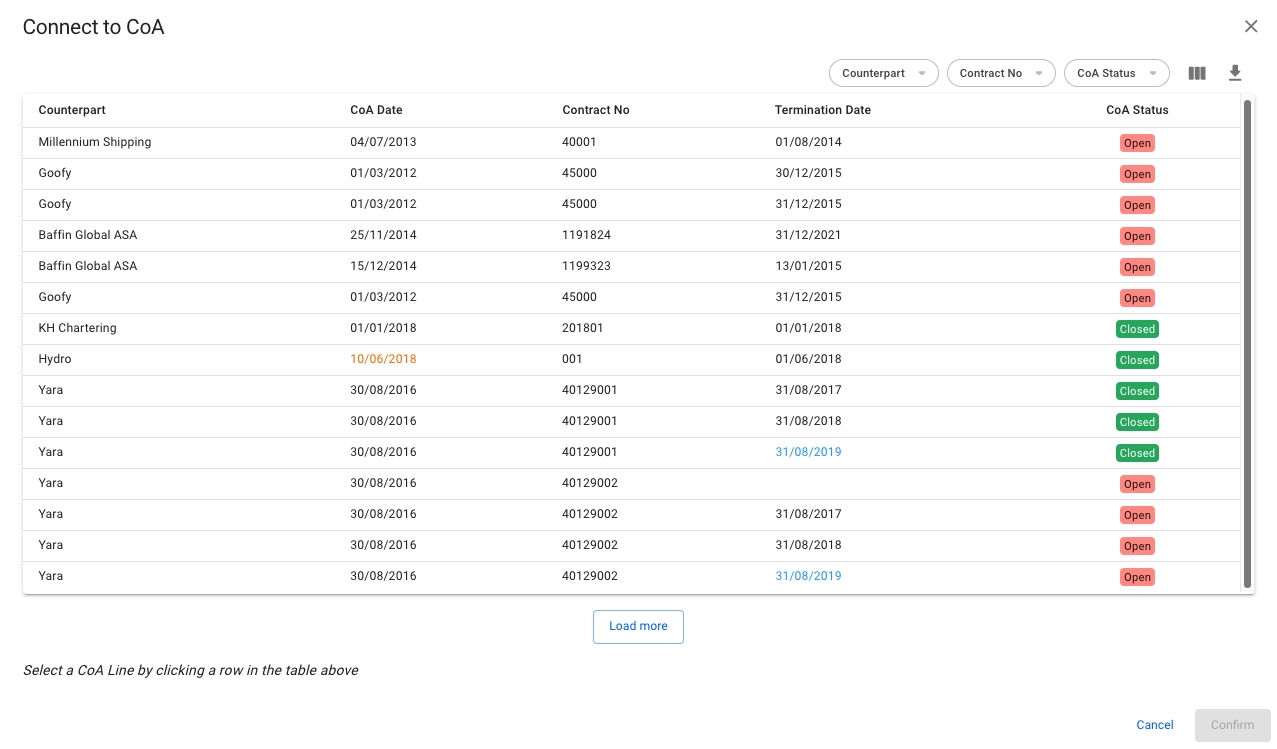
Loading...
Loading...
Loading...
Loading...
Loading...
Loading...
Loading...
Loading...
Loading...
Loading...
Loading...
Loading...
Loading...
Loading...
Loading...
Loading...
Loading...
Loading...
Loading...
In the Sub-cargoes tab you may enter sub-cargoes
By clicking the blue plus icon in the top right corner you can create sub-cargoes.
Once clicked the below modal will appear:
Once the required fields are filled in the create button will be activated and you may create the sub-cargo. The modal for editing a sub-cargo is identical.
At the top in the main details you will find the KPI-cards.
First tile: Cargo quantity is the actual quantity, and booked is the booked quantity.
Second tile: Gross freight is the total freight for the cargo.
Third tile: Commission and various costs.
Fourth tile: Net Fio is all cargo related revenue aggregated and then deduct all aggregated cargo cost - divided by the quantity of the cargo.
Below the KPI tiles is the Main Cargo Details section on the left side:
Booked Quantity
Quantity agreed in charter party (available when cargo status is before Clean Fix).
B/L Quantity
Sum of the quantities on all load cargo ports (available for cargo status Clean Fix and Loaded).
Freight Rate
Weighted average of freight rates on the discharge cargo ports.
Deadfreight Rate
Is set to Freight Rate value when creating a new cargo, or copying a cargo, by default. The field can be changed to a desired value after creation.
All fields that are enabled can be changed from this view. The following fields will be disabled under the following conditions:
Boooked Quantity/BL Quantity
The Cargo has one or more SubCargos, or if there are load/discharge amount on CargoPorts that are not the first in the timeline.
Minimum Quantity
Tolerance Option is not set to "MOLOO" or "LOO"
Cargo Measurement
The Cargo has one or more SubCargos, or if there are load/discharge amount on CargoPorts that are not the first in the timeline.
Freight Rate
The Cargo has one or more SubCargos, or the CargoPorts have different freight rates, or the Cargo has multiple freight rate tiers.
Rule
The cargo has one or more freight rate tiers.
Flat Rate
Rule is not set to "World Scale"
Tolerance
Tolerance Option is not set to "MOLCO" or "LCOPT"
Broker Commission
The Cargo has one or more Commissions connected to it
Demurrage Rate
One or more of the Cargo Ports have a demurrage rate
Despatch rate
One or more of the Cargo Ports have a despatch rate
Performance Cargo
The Cargo does not have a Voyage connected to it
Below Main Cargo Details section, there is a section for inputting fields and checkboxes regarding the stowage values of the cargo:
If the optional preference SF_INTAKE_CALCULATION is enabled on your company's system, stowage factor will change from being System Volume Unit / System Weight Unit, to Cubic Feet / System Weight Unit
Below the KPI-cards on the right side is the Cargo Port Timeline together with LayCan dates. Laytime used is the estimated laytime allowed. The date fields are validated and if the validation fails the date field that needs to be corrected is highlighted in red and there is a short message under the date field indicating what is wrong.
Editing a Cargo Port will give you access to a few more fields, for instance Handling Cost, Laytime Terms and related fields.
If the Vessel Type of the Vessel used for the Voyage has "Free Despatch" ticked off, any newly created Cargo Ports will have "Free Despatch" ticked off as well.
If the Port Call for this Cargo Port has 'Use Handling Cost from Service Order' checked off, the handling cost related fields will be disabled.
On the right side, below the Cargo Port Timeline section, you can create/edit and view a list of Bunker Adjustments on the cargo:
For both of these options you will be able to choose the bunker types: DL (LS MGO), DO (MGO), FL (LS FO) or FO. You can also input/edit the other fields, such as: Min Price, Max Price, Adjustment Factor/Agreed Consumption and Price. The Price field is still editable even though the input of the Min-/Max Price fields calculates the average price.
The total adjustment is calculated if the price is outside the minimum/maximum range, i.e:
Min range: 500, Max range: 550, Price: 600 => Positive adjustment
Min range: 500, Max range: 550, Price 400 => Negative adjustment
This calculation you can see as the price value in the second KPI tile by the last field called Bunker Adjustment:
Adjustment Type
Adjustment types, Mandatory(*), defaulted by "Freight"
Bunker Type
The different fuel types, Mandatory(*)
Min Price
Minimum price range, Mandatory(*)
Max Price
Maximum price range, Mandatory(*)
Adjustment Factor
Adjustment Factor, Mandatory(*), displays if Adjustment Type is set to 'Freight'
Agreed Consumption
Agreed Consumption, Mandatory(*), displays if Adjustment Type is set to 'Consumption'
Price
The price, Mandatory(*)
On the right side, below the Bunker Adjustment section, you can enter external reference, Trade, Cargo Text, Comment, Company, Business Unit and Cargo Operator:
At the bottom of this tab there is be a list of Relets and Transhipments for the cargo:
In the Freight Rate Tiers tab, you can create, edit and delete different freight rate tiers for the cargo. It is also possible to choose between a tiered and a volume rate model.
Tiered: In tiered pricing, the per-unit freight rates are assigned to quantity-based ranges (tiers). When calculating the total freight, quantities are purchased from successive tiers, starting from the lowest. Example: In the below example, a cargo of 8000MT would have a freight rate of 11 USD for the first 4999MT and a freight rate of USD 12 for the remaining 3001MT. The freight rate will show as a weighted average on the cargo.
Volume: Here too, the freight rate is quantity-based. However, the per-unit freight rate is dependent on the range within which the total quantity falls. So, under this model, you would define the quantity ranges and the per-unit freight rate for each. Example: In the below example, a cargo of 8000MT would have a freight rate of 12 USD for the entire quantity.
If a cargo has one or more tiers in this section, the Freight Rate and Rule field in the Main Cargo Details section will be uneditable. Rule will also be changed to Rate.
To delete one or more tiers, click on the checkbox mark on the left side of the list. Doing so will bring up the button to delete the tiers. Clicking on the button will bring up a confirmation modal.
In the Commissions tab you can create new commissions by clicking the -icon to open a dialog to enter values, where "Broker" is mandatory:
Once clicked the below modal will appear:
Once the required field is filled in the create button will be activated and you can create the new Commission, which then will appear in the table in the Commissions tab.
Navigate to these pages to read more about the various Cargo Drawer actions:
When you open the cargo drawer you see on the top left the vessel and voyage the cargo is allocated to, if it is an allocated cargo. You can click both chips to open the vessel drawer or the voyage drawer.
Next you see the cargo reference, which is a unique identifier of the cargo. You can edit the cargo reference under the three dots.
Then you see the cargo status and can change the cargo status.
You also see the Cargo Type, which is automatically set by the system.
Spot
Standard cargo, which fulfills none of the conditions below
Contract of Affreightment
Cargo which is connected to a contract of Affreightment
Relet
Cargo with a Freight Cost
Preshipment
Freight Cost Cargo related to a transshipment before loading
Transshipment
Freight Cost Cargo related to a transshipment after discharging
Has Transfer
First part of a cargo that is transported on two voyages
Transfer
Second part of a cargo that is transported on two voyages
By clicking the various tabs you get the relevant information about the cargo. Check out the next pages for information about the different tabs.
On the right side you have primary actions; PDF and copy. The three dots is a dropdown with secondary actions for the drawer. If you click the three dots you will be presented with the below view as a drop down:
You can allocate/unallocate the cargo to move it to a voyage, change the voyage it is on or remove it from the current voyage.
You can delete a cargo.
You can relet a cargo to another owner.
You can convert the cargo to relet to change the cargo to be a freight cost instead of freight revenue.
You can add a Transhipment, Preshipment or Transfer of the cargo.
You can also connect the cargo to a CoA and remove the CoA connection when connected.
And finally you have the option to view the audit log or append attachments to the cargo.
To maintain the cargo click the cargo in the list. The selected cargo will be opened in a cargo drawer where you can edit fields, copy cargo, create a pdf from the booking and so forth. Click the cargo drawer page here to see more details.
Learn about the cargo actions in FAS: .
In the various Cost/Revenue Tab there will be two tables. One table for various cost and one for various revenue.
To add a Various Cost click the blue plus icon in the top right corner. Once clicked the below modal will appear.
Once the required fields are filled in the create button will be activated and you can create the Various Cost.
To add a Various Revenue click the blue icon in the top right corner. Once clicked the below modal will appear:
Once the required fields are filled in the create button will be activated and you can create the Various Revenue.
To delete either a Various Cost or a Various Revenue select the item from the table by clicking the checkbox on the far left side.
Once one or more items are selected you can click the trashcan to delete the selected item(s).
In the Payment Terms tab you can enter the payment details as per above fields.
In the comments tab there is a list of previous comments made, and at the bottom you can add new comments.
Click a cargo in the Cargoes module list.
When the drawer opens, open the action menuin the top right.
Click the Allocate Cargo button to open a dialogue for allocation.
The allocation dialogue is a three-step process. Once you have selected a vessel, a list of all the voyages on the vessel will appear. Sort and filter the list to find the exact voyage you want, select it, and a preview of the voyage schedule will appear, with cargo ports on the left, and port calls on the right. The scheduler will attempt to link the existing port calls on the voyage with the cargo's cargo ports. If no port call exists, a new one will be created at the end of the voyage. These are denoted by a blue "NEW" chip. You can re-arrange the port calls by dragging and dropping.
When allocating, the cargo will also have its company and business unit changed to the voyage's company and business unit. You can edit the cargo's company and/or business unit after the allocating if you want it to be different from the voyage's.
Click Allocate to allocate the cargo. Any new necessary port calls will be created on the voyage.
To add a cargo port, click on the -icon in the top right corner. To edit a cargo port or delete a cargo port hover one of the cargo ports in the timeline and the below view will appear:
You can create a new Bunker Adjustment by clicking the -icon at the top right of the section, which will bring you to the Create-modal. Or you can click on one of the rows to edit the selected Bunker Adjustment, which will open the Edit-modal. If you choose the Adjustment Type to be set to "Freight", you will only see the Adjustment Factor field below. But if you have chosen "Consumption", you will only see the Agreed Consumption field below (the invisible field is not editable and does not affect the calculation). The Freight type is chosen by default.
To add another tier, click the icon in the top right of the list. This will bring up the modal to create a new tier. Enter the quantity from which this tier will be valid.
If the cargo has type , you will see the Contract Name it is connected to and can click the Name to open the CoA drawer.
When deleting a cargo you will be presented different options based on the cargo you are deleting
Cargoes are loaded and discharged in cargo ports and these cargo ports are linked to the port calls you find in the voyages schedule.
One port call can be linked to:
no cargo port - for port calls to Bunkering, Canal Passages etc.
one cargo port - when loading/discharging one cargo
more than one cargo port - when loading/discharging more than one cargo
When deleting a cargo the link between the cargo ports and port calls will define what options you will see in the delete cargo window.
When deleting a cargo which has cargo ports linked to a port calls which are linked to some other cargos cargo ports you will get a simple confirmation message before cargo is deleted as per below
The same confirmation message will always be shown for unallocated cargoes.
The Timeline shows the voyages schedule on the right side and the cargo ports of the cargo you are about to delete on the left side.
At the top of the drawer you can find a dropdown menu with available statuses for a cargo, which will open by clicking on the current status:
The cargo status is a helper for you to understand where in the process you are. All statuses apart from 'Clean Fix' are the same in the sense that they do not change the functionality of the system. When you set the cargo status to 'Clean Fix', the Cargo Quantity in the Cargo drawer changes to be B/L Quantity. Meaning, when changing the Cargo Quantity on a 'Clean Fix"'cargo, it only changes the B/L Quantity, and not the Booked Quantity.
For a cargo, you can change the status to 'Loaded' only from the status 'Clean Fix'. You are also able to change back to 'Clean Fix' from the status 'Loaded'. The same Deadfreight/Overage, Booked Quantity, etc. calculations will happen when in these two statuses. Likely, this status will be used to mark the last transition of a cargo.
All cargoes on a voyage will have their status changed to 'Clean Fix' when the voyage is changed to 'Nominated' status. The only exception to this is if the cargo already has status 'Loaded'.
A relet can be defined as the act of sub-chartering a cargo to other owners to transport. A relet always covers the entire voyage of a relet cargo.
Relets are listed at the bottom of the cargo drawer under "Relets and Transhipments".
Open the Cargoes module in the Core section.
Click a cargo in the list to open it in a drawer.
At the top right in the drawer, click More and select Relet to Another Owner.
Fill in the "Owner" field and click Confirm.
Reletting a cargo will create a copy holding most of the same data of the cargo to be relet in the system. This new cargo has cargo type and thus it is has a freight cost instead of a freight revenue.
that was relet.
Find the relet listed under "Relets and Transhipments" in the cargo drawer and click to open it.
At the top right in the drawer, click Moreand select Delete.
Editing the cargo quantity, measurement unit, commodity or the planned BL Date of a relet cargo or its connected cargo will trigger an identical change on the other cargo to keep them synchronised on these fields.
If you click the Connect to CoA button in the secondary actions menu on in a Cargo Drawer,
you will open the Connect to CoA modal:
In this modal you choose which CoA Line you want to connect the Cargo to and click Confirm to connect it. Doing so will update the Company and Business Unit of the Cargo to be the same as the Company and Business Unit of the CoA.
When you have connected the cargo to a CoA Line, you will see a chip at the top of the Cargo Drawer that says Contract of Affreightment as well as which CoA Line you've connected it to (40129002 in this example).
The CoA number chip (40129002) is a clickable chip that will open up the drawer of the CoA.
A cargo transfer is a type of where a cargo is transported on two voyages. The cargo is transported on the first voyage to an intermediate port and then further transported on a second voyage to its final port.
You start with a cargo with a load and discharge port which represents the first part of the cargoes journey (on the first voyage). From a system perspective, the action "transfer" creates a new cargo for the second part of the journey (on the second voyage).
The original cargo will receive cargo type "Has Transfer", and the new cargo will receive cargo type "Transfer."
The following fields are synchronised:
cargo quantity and measurement unit
commodity
discharge rate + terms of has transfer cargo = load rate + terms of transfer cargo
Transfer cargoes are listed at the bottom of the cargo drawer under "Relets and Transshipments".
Open a cargo drawer.
At the top right in the cargo drawer, click More and select Transfer.
Fill in the form fields:
Owner of the vessel to transship the cargo.
Final discharge port of the transfer.
Second vessel to transport the cargo.
Second voyage to transport the cargo.
Click Transfer.
The discharge port of the original cargo will be the load port of the transfer cargo.
When a cargo has been connected to a Contract of Affreightment (CoA), a secondary action called 'Remove CoA' will be enabled which will allow you to revert the connection and disconnect the cargo from the CoA. If the Cargo does not have any CoAs connected, the Remove CoA button will be greyed out and disabled. The Secondary Action menu is opened by clicking the triple-dot icon in the upper right of the Cargo Drawer
Clicking the 'Remove CoA' button will instantly disconnect the CoA link from the Cargo.
The convert cargo to relet function gives you the possibility to change your cargo from generating a freight revenue to instead generating a freight cost.
Open the Cargoes module in the Core section.
Click a cargo in the list to open it in a drawer.
At the top right in the drawer, click More and select Convert Cargo to Relet.
The cargo type will now change to be and the cargo freight will be considered a cost in the voyage profit and loss calculation.
Open the Cargoes module in the Core section.
Click a cargo in the list to open it in a drawer.
At the top right in the drawer, click More and select Convert Cargo to Non-Relet.
The cargo type will now change to be or and the cargo freight will be considered a revenue again in the voyage profit and loss calculation.
A transshipment is the shipment of cargo to an intermediate destination, then by a different vessel to another destination. It is a type of created from a cargo booking from a particular discharge port at the end of an original booking.
A preshipment is another type of relet created from a cargo booking. It is the transportation of a cargo from a location to that cargo's load port in an existing cargo booking.
Transshipments and preshipments are listed at the bottom of the cargo drawer under "Relets and Transshipments".
Open the Cargoes module in the Core section.
Click a cargo in the list to open it in a drawer.
At the top right in the cargo drawer, click Moreand select Transship or Preship.
Fill in the fields listed below.
Click Confirm to relet the cargo.
The To Port will be automatically added to the cargo field Final Destination.
The From Port will be automatically added to the cargo field Place of Origin.
When deleting a cargo which has cargo ports linked to port calls which are not linked to any other cargoes cargo port you will get option to also delete the linked port calls. This makes it easier to keep your schedule clean and correct.
When ticking the checkbox the port calls marked in red will also be deleted from the schedule.
Field
Description
Owner
Owner of the vessel to transship the cargo.
From Port
A discharge port in the cargo booking.
To Port
The final destination.
Field
Description
Owner
Owner of the vessel to preship the cargo.
From Port
The originating port.
To Port
A load port in the cargo booking.





